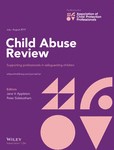The year 2016 marks the 25th anniversary of Child Abuse Review and I am pleased to announce that our first issue of the anniversary volume is now freely available online. The issue contains five stimulating original articles along with two training updates, two book reviews, and our accompanying editorial.

The primary paper to launch this anniversary volume is Nigel Parton’s review of the contemporary politics of child protection, based on his Founder’s lecture at the 2015 BASPCAN congress in Edinburgh. Parton provides a wide-ranging review of the issues facing child protection in the UK today and his paper is well worth reading.
Over the past 25 years a lot has changed in the child protection field.
Parton argues that the child protection systems introduced through the Children Act 1989 were in response to a number of high-profile cases of physical and sexual child abuse within the family, and that this created a tension between professionals intervening ‘too little and too late’ or conversely, ‘too early and too much’.
‘The Children Act 1989 was thus centrally concerned with trying to establish a new set of balances between the state and the family in the care and protection of children. I argued (Parton, 1992) that the idea of child protection at that time, in the early 1990s, was essentially concerned with both the protection of children from ‘significant harm’ in the family and also the protection of the family from unwarrantable and inappropriate state interventions. Crucially the focus of law, policy and practice was how we could best address the abuse of children within the family and the primary concerns were physical and sexual abuse.’
Over the past two decades, however, the nature of child protection has changed, and reflects broader shifts in our culture. The recognition of both physical and sexual abuse within a variety of institutions and community settings, along with research highlighting the long-term impact of chronic abuse and neglect, has led to a broadening and an increasing complexity of what now constitutes child protection or safeguarding:
- An increasing focus on the full range of the life-course from pre-birth to young adulthood, particularly as the dangers of child neglect in the early months of life and its impact on the brain and child development have received considerable attention;
- The recognition that young people themselves, as well as adults, can perpetrate abuse;
- The growth of new dangers including those related to the internet and a range of forms of social media and, most recently, the dangers of ‘radicalisation’;
- The identification of new forms of abuse which include female genital mutilation, forced marriage and child sexual exploitation.
Within this context, child welfare professionals across the country work incredibly hard to support families and protect children. In the research I am currently working on for the Department of Education, we have identified a year-on-year increase in child protection activity, but in spite of this, no change in the number of deaths directly caused by maltreatment, and, if anything, a reduction in fatality rates in all but the late adolescent group.
During the years 2011-14, a total of 1,856,400 referrals were received by children’s social care services in England, an average of 619,000 per year.
However, in contrast to this recognition of the extremely good and sensitive work being done by professionals, Parton argues that ‘debates about child protection have become increasingly emotionally charged and politicised’ with what he calls ‘a politicised narrative of blame and failure’. Rather than being seen as motivated professionals who are committed to working for children’s safety and well-being, child protection workers are blamed both for failing to protect children and for disrupting families.
In a complex world in which children grow and thrive, are abused, exploited and neglected, have fun and participate, laugh, play, cry and cower in fear, we need to challenge this culture of blame and failure, and instead work to support children and families, and the professionals who work with them every day. We need to move to a narrative of ‘progress and hope’, celebrating all that has been achieved in supporting children’s rights, and taking those opportunities to learn and improve.
I’d encourage you to take a look at Nigel Parton’s paper and the other papers in this special anniversary edition of Child Abuse Review.
Jane V Appleton & Peter Sidebotham. 25 Years of Supporting Professionals in Safeguarding Children (pages 3–8)
Original Papers
Nigel Parton. The Contemporary Politics of Child Protection: Part Two (the BASPCAN Founder’s Lecture 2015) (pages 9–16)
Li Eriksson et al. Maternal and Paternal Filicide: Case Studies from the Australian Homicide Project (pages 17–30)
Mary Hughes & Jill Cossar. The Relationship between Maternal Childhood Emotional Abuse/Neglect and Parenting Outcomes: A Systematic Review (pages 31–45)
Emma Katz. Beyond the Physical Incident Model: How Children Living with Domestic Violence are Harmed By and Resist Regimes of Coercive Control (pages 46–59)
Julie Taylor et al. Disabled Children and the Child Protection System: A Cause for Concern (pages 60–73)
Training Updates
Child Protection and Disability Toolkit by WithScotland and the Scottish Government’s Ministerial Working Group on Child Protection and Disability, 2014.
Tiny: Toolkit produced by St Michael’s Fellowship and Latimer Creative Media, London, 2013.
Book Reviews
Filicide-Suicide: The Killing of Children in the Context of Separation, Divorce and Custody Disputes by Kieran O’Hagan, Palgrave Macmillan, Basingstoke, 2014.
Children and Young People with Harmful Sexual Behaviours by Simon Hackett, Research in Practice, Dartington Hall, Totnes, 2014.






